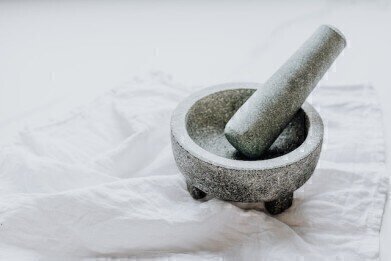Laboratory Products
The Importance of Cleaning Your Lab's Pestle and Mortar
Sep 01 2022
More than just a kitchen utensil, a pestle and mortar is a staple in most scientific laboratories. Made from durable materials, they’re used to grind components, samples and specimens into granular particles. Cleaning is an important step as a soiled pestle and mortar can compromise the accuracy of results and the safety of laboratory personnel.
Like glassware, cleaning laboratory pestle and mortars requires a specialised approach. Without the right cleaning steps, they can become a major source of contamination.
Applications for laboratory pestle and mortars
Before we dive into best-practice cleaning protocols, let’s take a closer look at how pestle and mortars are used in the laboratory.
-
Accelerate reaction rates of solutes
Increasing surface area can significantly accelerate the reaction rates of solutes such as solid-state chemicals. This makes it easier for the chemicals to dissolve when added to a solution.
-
Breaking solids into smaller particles
Many laboratories rely on liquid solutions to carry out experiments. Pestle and mortars are a quick, easy and safe way to break solids into smaller particles. Depending on the texture required, solids can be ground into smaller fragments or a fine powder or paste.
How to clean laboratory pestle and mortars
To minimise the risk of cross contamination, the following steps can be used to clean laboratory pestle and mortars:
-
Remove particles and debris
Most laboratory pestle and mortar cleaning protocols start with particle removal. Use a wire brush or clean towel to loosen debris and remove particles. This is an important step as previously used particles may react with water.
-
Clean with hot soapy water
After debris has been removed, use hot soapy water to clean the pestle ad mortar. Ideally, choose a fragrance-free soap for this step.
-
Allow to air dry
Place on a clean rack and allow to air dry.
-
Rinse with isopropyl alcohol
After drying, rinse with isopropyl alcohol to remove excess dirt and dust. This preps the pestle and mortar for future use.
-
Rinse with hot sulfuric acid
For biochemistry applications, a rinse with hot sulphuric acid may be necessary to remove all remaining traces of chemicals and other contaminants.
-
Wash with diluted sodium bicarbonate
The hot sulphuric acid step can be followed with an additional wash using diluted sodium bicarbonate.
-
Rinse with deionised water
Conclude with a rinse in deionised water.
-
Bake for 30 minutes
Bake for half an hour at 110°C in a laboratory oven.
Find out more about gold-standard cleaning practices for other lab equipment and utensils, including glassware and pipettes in ‘Laboratory Hygiene - A Comprehensive Guide’.
Digital Edition
Lab Asia 31.2 April 2024
April 2024
In This Edition Chromatography Articles - Approaches to troubleshooting an SPE method for the analysis of oligonucleotides (pt i) - High-precision liquid flow processes demand full fluidic c...
View all digital editions
Events
Apr 28 2024 Montreal, Quebec, Canada
May 05 2024 Seville, Spain
InformEx Zone at CPhl North America
May 07 2024 Pennsylvania, PA, USA
May 14 2024 Oklahoma City, OK, USA
May 15 2024 Birmingham, UK



.jpg)














